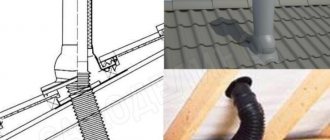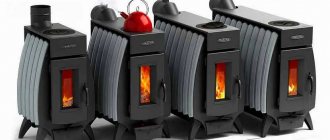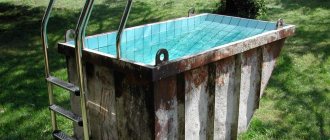An autonomous heating system has many advantages, including the ability to regulate temperature, and, consequently, saving money on fuel consumption. Steam heating, among other things, is an effective method of heating a home due to its low installation cost. In addition, if a conventional stove is installed in the house, you can install steam heating from it yourself, despite the difficult installation.
Wood-burning brick oven
If stove heating is used to heat the home, then the main question that needs to be resolved is where to install the heat exchanger or steam generator.
There are several options. The generator can be a coil or a boiler. To ensure that the water in the generator heats up quickly, it can be installed directly into the firebox. The water will boil quickly, but the equipment will soon become unusable. It will be under constant exposure to fire.
The coil is built into the brick walls of the furnace, filled with mortar. This design will last a long time. The water will absorb the heat that is transferred through the brick walls. It will boil quickly. This design option has some disadvantages. If a breakdown occurs in the coil, it will be impossible to eliminate it. You will have to disassemble the furnace wall and install a new heat exchanger.
It is not recommended to install the steam generator close to the wall. Soot and dirt can get into the niche. It should be possible to clean the surface of the coil and the niche itself. The steam line can be connected to the boiler or directly discharge steam to radiators or to the “warm floor” system.
The system must be equipped with control devices to regulate the temperature and steam pressure. The optimal outlet temperature is 150 0C. The pressure at the outlet to the steam line is 170 kg/m2. When installing the main line, it is not recommended to use fittings. The pipes are connected by welding seams.
We build a coil from iron sheets
The metal layer must be at least 5 mm for this element. When collecting, a 60*40 mm profile and 5 mm pipes are also used; they are designed to remove water and water mass. The overall size of the device depends on the length of the fuel part of the stove.
The metal layer must be at least 5 mm for this element
If the element is ultimately installed in the heating and cooking system, then the optimal solution would be to ensure that the gas warms the coil shelf and goes into the smoke channels, which will be located in front of the exchanger. With this calculation, it is easy to place a surface for cooking.
The part can also be made in the form of a book if you connect the outer panels with tubes or a profile. But with such a structure, the top shelf will be missing. And for optimal cross-country ability you need to place connecting tubes in the upper part. It is better to organize the inlet and outlet behind the heat exchanger or on its side.
Which pipes are suitable for a steam heating system
The cost of a steam-type heating system largely depends on the pipes used. In systems of this type, three types of pipes are used:
- Copper pipes
are considered the most reliable and more practical. But not everyone can afford them, since their price is quite high. However, it is this type of pipe that is able to withstand the fairly high temperature that steam can create; - Stainless steel pipes and galvanized pipes
are also characterized by high reliability and durability. In addition, it is quite simple to carry out work on connecting pipes of this type, since they are joined together using threaded connections; - steel pipes
are not the best option due to the fact that steel is susceptible to corrosion. But this applies only to those steel pipes that have not been treated with special agents to prevent corrosion. Installation of a pipeline made of steel pipes involves welding. If pipes that are protected from corrosion are selected and all installation work is carried out correctly, then such a pipeline will serve for a long time.
Two-pipe system
The steam heating system can be two-pipe. In this case, steam and condensate pass through different pipes. More consumables will be required, but the risk of water hammer in the line is minimal.
With a single-pipe system, the condensate level may exceed the steam level. The coolant outlet is blocked. This leads to a sharp increase in pressure in the device or pipes. A water hammer occurs, which may be accompanied by a rupture of the main line. With a two-pipe system, condensate is removed and does not interfere with the flow of coolant to the devices in the room. Steam heating at the dacha is done with their own rivers according to a certain scheme.
- Install the boiler and radiators in the areas provided for them in the house.
- The chimney is removed from the boiler at an angle of 300.
- It is necessary to install an expansion boiler in the attic.
- Pipes for steam inlet and condensate outlet are removed from the radiators. For heating to be effective, steam must enter the device from above. For condensate, an outlet is made from below.
- A pipe through which coolant will be supplied is led out of the expansion tank at an angle. It is connected to the hot circuit: all radiators are connected.
- The steam line is connected to the outlet pipe in the boiler.
- The condensate line is removed from the last radiator. It is connected via fittings to the lower pipes in the radiators.
- A container is provided to collect condensate. The condensate pipeline approaches it vertically.
- A pipe for liquid outlet is removed from the tank. Strengthen the pipe at an angle to the boiler. At the outlet of the tank, a water filter and a circulation pump are installed, which will pump liquid into the water circuit located in the boiler. It is recommended to remove the air pipe in front of the pump. Air will pass through it into the atmosphere, which will prevent the pump from airing.
- The highway is being closed. All connections are checked and pressurized.
- Testing the heating system.
To be able to install hot water in the house, it is necessary to provide an additional circuit. Through it, hot water will flow from the boiler to household appliances in the kitchen, bathroom, and toilet. For water heating, the circuit can be removed from the expansion tank. With steam heating, the hot water line leaves the condensate collection tank.
In order not to make corrections to the country heating pipeline, it is recommended to purchase double-circuit boilers or equip the stoves with an additional heat exchanger. There is already an outlet for water supply from the furnace or boiler. If a furnace with heat exchangers is built independently, then a steam line is removed from one coil, and a pipe for hot water is removed from the other.
Installing steam heating in a country house is a profitable undertaking. For a small home, a single-pipe system is well suited. For multi-storey cottages, it is recommended to consider a two-pipe main.
Condensate is used for domestic needs: the water is hot, cools down to a temperature of 60 0C. To install a separate DHW pipeline, boilers with a double water circuit are purchased.
YouTube responded with an error: Daily Limit Exceeded. The quota will be reset at midnight Pacific Time (PT). You may monitor your quota usage and adjust limits in the API Console: https://console.developers.google.com/apis/api/youtube.googleapis.com/quotas?project=268921522881
Work technology
If the house does not initially have a stove, then you first need to partially open the floors to place the foundation, lay the foundation, and cover it with roofing material.
The first row is laid on waterproofing. The following are placed in order, controlling the vertical with a level or plumb line. Fire-resistant wire is inserted at the door installation sites, tying the door contour.
The firebox is laid out according to the previously described technology.
The chimney is made of two layers. A metal pipe is installed as a base, and the outside is tied with thermal insulation. All that remains is to lay bricks around it, leaving space for the damper.
For safety, each connected radiator is equipped with shut-off valves and air release valves.
Mayevsky tap on the radiator
At the beginning of the heating system, a cooling reducer and pressure reducing valve are installed, and a condensate tank is mounted at a slight slope. The liquid from it will be directed to the heat exchanger. A circulation pump is installed in front of the furnace.
Single-pipe scheme
If the country house is small, less than 100 m2, then it is more economical to use single-pipe heating for heating. The coolant and condensate in this case will be in the same pipe. Installation diagram:
- boiler containing the steam generator;
- steam line;
- radiators;
- condensate line;
- the highway is closed.
For an area of 100 m2, a boiler of no more than 10 kW will be required. This power will be enough for normal heating of the house. To ensure that the water in the boiler heats up quickly, gas, electric boilers, and stoves running on diesel fuel or waste oil are used.
A brick wood stove or fireplace looks attractive, but it takes a long time to heat up. The advantage of wood heating is that it is completely autonomous. If the house is connected to a gas main, then they use a gas stove, but choose equipment with piezo ignition, which will make the heating independent, independent of electricity.
To connect individual sections of the system, galvanized fittings are used. Tow is used as a sealant. Radiators are also purchased from galvanized steel. If the rooms in the house are small, then heating devices are not installed. A pipe is laid around the perimeter of the room. It will act as a heater.
You must always remember that steam comes out under a pressure of 170 kg/m2. Its temperature is 150 0C, its speed is 30 m/s. If the pipes are connected poorly, the line will rupture, which will be accompanied by a powerful flow of steam. Before starting work, it is necessary to perform a pressure test of the system to identify the places where air passes from the pipes.
Where do you start installing a heating system? First, the entire diagram is transferred to a sheet of paper. The drawing indicates the location of all elements of the system and the length of the pipeline in individual sections.
- Install the boiler. A separate area must be equipped for a wood-burning stove. The walls are protected from high temperatures with asbestos sheets. The stove is located away from interior items. The gas boiler is mounted on the wall. A chimney is installed for heating units. It should exit the oven at an angle to increase draft.
- Install radiators if necessary. They are fixed to the wall on brackets. Distance from the floor 10 cm, from the window sill 10 cm, from the wall 5 cm.
- Pipes of the appropriate diameter are supplied to the radiators. To create a slope, the pipe is raised: 0.5 cm by 1 m towards the boiler. Fittings are used for connection. All heating devices are connected one by one.
- A pipe is removed from the last radiator: a loop is installed. It is necessary to make the condensate pipeline inclined to the boiler 0.5 cm/m.
- The main is closed: the pipes are connected to the boiler.
- If a high-power boiler is used, it is recommended to install an expansion tank to remove excess steam. The tank is installed in the attic. A steam line from the boiler leads to it and a pipe goes down to the radiator.
To be able to remove the radiator without affecting the main line. Bypasses and ball valves are installed on the sides in the lower corners. If there is a need to change or repair the device, the taps shut off the access to steam, the radiator cools down: it is ready for repair work.
Various schemes for steam heating of a private house
There are several types of steam heating schemes. So, you can even do the heating yourself. However, to do this you need to know several of its options.
Closed and open piping
There are two types of the above-mentioned autonomous heating, in particular, closed, and also open, which depends on the condensate entering the end point of heat (radiator).
A closed system is characterized by the fact that in it condensate from the heating elements enters the heat source due to the presence of a pressure difference. At the same time, for proper heating operation, the steam collector must be placed lower compared to the heating elements.
Closed-loop steam heating circuit
When the heating system is open, condensate enters the storage tank independently (by gravity). Using a pump, it is pumped into a heat source. In this type of heating, condensate drains freely from the outermost radiator into the condensate accumulator.
Open-loop steam heating circuit
Two-pipe or one-pipe system?
Steam autonomous heating can be one- or two-pipe. Typically, a single-pipe heating system is not often used (this makes it difficult to regulate the existing heat flow: special devices are needed for control).
More practical two-pipe heating. It is easily regulated: at the point where the steam enters the radiator, a special valve is installed for adjustment, and at the point where the condensate exits, thermostatic condensate drains are installed. Therefore, this type of heating is low noise.
We focus on the pressure in the heating system
Autonomous steam heating systems differ in the connection of heating elements, in the type of location of steam outlets and condensate outlets.
Autonomous heating with low pressure
As you know, pressure arises in the boiler during operation, which forces steam to move into the riser and into the distributing steam pipeline, from which risers extend to the radiators. Steam lines with special valves for adjustment are connected to the heating radiators. Entering the radiators, the steam comes into contact with their walls and cools. This gives off heat. During this process, condensation forms. It enters the boiler again through the condensate line.
Low pressure steam heating system
Autonomous heating with high pressure
At the beginning of the high pressure steam line it is 0.7 kgf/cm2. Such systems are found only with a closed loop. When steam is generated, it is collected and sent to a comb for distribution. A special valve is specially installed in the comb, which controls the setting of the permissible pressure. For subsequent repairs of the valve, a bypass is installed in advance.
The steam then flows to the radiators. It is necessary that there is sufficient pressure throughout the entire system. This is necessary to remove condensation. In this case, the temperature of the condensate is almost the same as the temperature of the steam.
High pressure steam heating circuit
Valves are installed in the steam pipeline in some places (at the entrance to it, at the outlet from the radiators). To control the pressure, a pressure gauge is installed. The system is also provided with compensators to, accordingly, compensate for temperature expansion in the pipeline.
Vacuum-steam heating
This steam heating scheme for a private house works using a pump that creates low pressure in the boiler itself. With its help, steam and condensate move through the autonomous heating system.
If you have a stove
The above-mentioned steam autonomous heating schemes can be equipped, in particular, in residential buildings using existing stoves. The method of assembling the system and pipeline is identical to other types of steam heating. But at the same time, there will be no radiators in the room where the pipe is discharged, unless the above-mentioned room is more than 40 square meters.
When installing steam heating, it is necessary to strictly follow the technology. It is necessary to calculate everything in advance, taking into account possible nuances. For reliability and accuracy, all calculations must be entrusted to specialized specialists. We were pleased to present you with current steam heating schemes for a private home. By following our recommendations, you will definitely achieve a positive and desired result.
What is steam heating
Steam heating is a system that uses steam as a coolant. How steam heating works in a private house: water boils in a boiler (heat source) and steam is transferred through pipes to heating devices. When moving through pipelines, the coolant condenses and settles on the inner walls of the radiators, giving off almost all of the heat. The batteries heat up themselves and transfer heat to the room.
The condensate formed after the carrier settles returns to the heating source by gravity - if the system is closed or using a pump (in open structures).
Advantages and disadvantages of steam heating
Experts note the following advantages of steam heating:
- Increased productivity. In a private house, you won’t need to install a lot of radiators, and in some cases, pipes without radiators are enough.
- Low inertia. To feel the warmth in the room, 10-12 minutes from the start of heating the boiler are enough.
- Reduced heat loss makes the steam heating system as economical as possible; you don’t have to buy expensive equipment to equip the structure.
- Easy to install. The process of forming a network in a private home is not complicated and can be done with your own hands.
Minuses:
- high temperature of operating devices;
- lack of smooth regulation of room heating temperature;
- restrictions on the choice of material (pipes must be metal only).
It may also be difficult to connect taps to a running system when the elements are heated to 100 C; any touch causes a burn.
To control the heating structure in a private home, experts recommend installing an automatic system that, when the air in the rooms cools down to a certain level, will put the entire system into operation. It is also possible to install automation not on one main branch, but on each (parallel) one, in order to separately start heating a particular room - this is more convenient and economical.
It is precisely because of the threat of accidents that the system is not used in multi-apartment buildings, and in private houses it is installed only under the personal responsibility of the owner.
Characteristics and diagram of the device
The principle of operation is based on the release of heat as a result of the conversion of the coolant, precipitation into condensate, which is removed from the devices and again enters the boiler.
- In a closed system, where the condensate returns to the boiler by gravity under the influence of the difference in temperature and pressure in the heating units. For boilers in such systems, the most important indicator is the temperature and pressure height.
- In an open-loop system, condensate accumulates in a tank, from where it is pumped by a pump or pump to the heating station. When setting up such a scheme, it is necessary to ensure unhindered drainage of condensate into a special tank from the lower heating device.
Based on steam pressure, an open-loop steam heating circuit can be of 4 types:
- subatmospheric;
- vacuum-steam;
- low blood pressure;
- high blood pressure.
The maximum permissible threshold for heating steam is up to 130 C, but for a vacuum-steam, sub-atmospheric pressure system, the ambient temperature is much lower than +100 C. Such steam heating schemes make it possible to change the magnitude of the vacuum (vacuum) and adjust a comfortable temperature regime. The advantage is the absence of complex units when arranging heating. There are enough steam lines (pipes for transporting the medium) and condensate lines (for transferring condensate to tanks) to start a steam boiler and get an efficient home heating system.
Types of furnace equipment
Furnace equipment refers to the structural elements that are used during the installation and operation of the stove. In cast iron stoves, they are already included in the kit from the manufacturer, but when connecting an additional water circuit to them, you will have to purchase additional elements for the stove:
- Pipes
. These can be plastic or metal pipes. Preference is always given to metal ones, as they are more reliable, but plastic ones are cheaper. The disadvantage of plastic pipes is the possibility of their melting at the joints with metal. Metal ones do not have this drawback.
- Diaphragm (expansion) tank
. It is necessary to maintain constant pressure in the pipes. When heated, the water begins to expand and enter this tank, so the pipes will not collapse from excess pressure. When cooling, excess water from the tank begins to gradually flow back into the pipes.
You can’t do without an expansion tank for any method of heating a house. Source koffkindom.ru
Radiators. They are usually installed directly under the windows. They increase the heat transfer of the water circuit. Water pump. It is required for water circulation in the circuit. Its installation helps to quickly heat the room, since the heated water quickly enters the radiators and heats the room. Without a pump, the movement of water through the pipes is carried out by gravity, but for this it is necessary to make special slopes, calculate the difference in heights and the difference in temperatures of the first circuit with heated water and the second circuit with cooled water - it is also called return. Heat exchanger. It is installed in the furnace firebox, above it, or on the chimney. All options have their advantages and disadvantages. This is a kind of boiler in which water will subsequently be heated
For chimneys, the heating tank is made in the form of a coil; for a firebox, it can have an arbitrary shape, but it is very important that it has a sufficient area of contact with the stove flame.
Scheme of operation of stove heating with a pipelineSource m.yukle.mobi
Galvanized products
In liquid and steam heating, the temperature of the coolant is different. The temperature of the water leaving the boiler can be 90 0C. In the main it gives off heat, the indicator drops to 60-70 0C. The outlet steam can have a temperature of 150 0C. In the system, this parameter is reduced to 120-100 0C.
When installing a heating system, these indicators must be taken into account. For heat supply with steam coolant, only galvanized and copper products are used.
Heating from plastic pipes is used if the coolant is liquid: most often it is water or a mixture with antifreeze. Steel products are not suitable. The material oxidizes quickly; in a short time the highway will become unusable. What are the characteristics of galvanized pipes?
Galvanized steel has increased strength
The main line, with correct diameter calculations, can withstand the force of water hammer, which is very important for steam heating. A cracking sound in pipes should alert household members. The material has sufficient elasticity to be resistant to significant loads: elevated temperature and pressure
Pipes do not deform under constant exposure to steam that enters the main line. Products undergo a galvanizing process on both the internal and external surfaces. The material is resistant to corrosion: does not react with water and salts. Zinc has antiseptic properties, which is an advantage of galvanizing. The products are lightweight and installation is easy. When using thermodiffusion galvanized pipes, welding skills are required.
Galvanized pipes
Water, gas, electric-welded, and profile pipes are made from galvanized steel. Only seamless products are suitable for steam heating. Wall thickness 5.5 mm. Alloy or carbon steel is used for their production, which makes them durable and reliable. There is no risk that the seam may tear under high loads. Operational life more than 50 years.
During installation, the pipes are cut and special devices are used. When connecting parts, welding is not used. The high temperature achieved during welding has a negative effect on galvanizing. She is burned. In addition, zinc vapor causes severe poisoning.
The connection is made with fittings, couplings, and tees are installed. All parts must be galvanized. Otherwise they may rust. FMU is not used as a sealant; tow, a dye with heat-resistant properties, is used.
The vapors evenly distribute the substance over the entire surface of the product. This creates a protective layer of increased strength. It does not burn or deform when exposed to high temperatures during welding: it can withstand temperatures of 470 0C without any changes.
Pipes have high thermal conductivity, quickly give off heat, but they also cool down in a short time. It is necessary to maintain a certain temperature of the coolant in order to create a comfortable temperature in the room. Steel heats up quickly. This means the heating system will warm up in a short time.
Some useful tips
When installing a steam heating system, you should remember that all its elements must withstand high temperatures, more than 100 degrees. For example, a conventional membrane expander will not work as a reserve tank in case of an increase in coolant volume, because its maximum is 85 degrees.
The chimney of a stove with a built-in heat exchanger will become dirty faster than that of a conventional stove. Therefore, chimney cleaning needs to be planned and performed more often.
If desired, an oven with a heat exchanger can also be used for cooking, but this is not very convenient. In summer, when heating is not needed, this stove cannot be lit. We'll have to look for an alternative. It’s easier if there is a separate, convenient stove for the kitchen in the house.
How to design and assemble a steam heating system with your own hands is described in detail in this article, which we recommend for reading.
Steam heating advantages and disadvantages
Steam heating system
In the middle of the last century, the use of steam for heating premises was widespread. Currently, the installation of structures to provide this type of heating is practically not used.
This type can only be found in production, and only because steam is generated as a result of the activities of enterprises, and its use can reduce energy costs, which may be required when choosing a different heating system.
The advantages of steam heating include:
- the use of pipes with a smaller diameter compared to pipes for water heating;
- no heat loss;
- due to the special physical properties of steam, the system quickly heats up;
Disadvantages of steam heating:
- the possibility of getting burned due to contact with heated parts of the system structure;
- comparative fragility.
The main component of a steam heating system is a boiler for heating water, during which steam is generated. Then the boiler accumulates the required amount of steam, which is then distributed through the mains to all heating devices. It condenses in them, and in the form of water, returns back to the boiler. Then the cycle repeats.
Heating systems are divided into two types in accordance with the mechanism for returning condensate to the water heating boiler:
- open - such systems contain a special tank in which the required amount of condensate is collected, which is then pumped into the boiler;
- closed - systems are equipped with a large diameter pipe through which the condensate independently returns to the boiler.
Electric heating and combination of several types
Electric heating system
Heating with electricity is widespread in Western countries. In Russia, this option is rarely considered due to the high cost of electricity.
If you want to install a heating system of this type, then you should take care of installing heaters (heat exchangers), heat curtains and possibly other equipment.
Installing electric floor heating will also help to heat the rooms quite effectively. But a more economical way is to install an electric boiler (you can make it yourself or purchase it), which is connected to a water heating system.
If you plan to have an electric heating system in your home, then you should take care of installing a zone electricity meter, the advantage of which is that it meters only 40% of the actual energy consumed at night.
To correctly calculate and install the equipment necessary for the proper functioning of the heating system, you need to have certain skills and knowledge.
If you are not entirely confident in your construction and installation abilities, the best solution is to turn to specialists. In this case, your home will be well heated and comfortable during the cold seasons.
Arguments for"
The steam method quickly heats the air in the house.
A wood burning system is a more economical option than gas or electricity.
It is not necessary to demolish the stove, since in addition to the expenditure of effort and time, major repairs may be required.
Due to the absence of mechanisms, any adjustment is carried out manually, which means that the equipment will not break down or malfunction.
This is an option for a dacha or country house, since the presence there is seasonal, and fuel can be stocked up in advance. The heating will not turn off due to bad weather, non-payment of electricity or gas.
Even if the furnace itself is located in a neighboring building, it is possible to install a steam system. The main thing is to take care of thermal insulation.
How to do this is clearly shown in the following video:
Pipe selection
Copper thin pipes
When it comes to pipes for steam heating, everything primarily depends on the preferences of the consumer, the owner of the house.
At a dacha in a private household, or in a cottage, heating can be made of different materials (steel, copper, stainless steel, etc.).
Steel pipes
Installation of steel pipes involves welding work.
Meanwhile, such a pipeline, distinguished by its high strength and reliability, has one significant drawback - over the years it becomes covered with corrosion.
Stainless and galvanized
Stainless and galvanized pipes, unlike steel ones, are resistant to corrosion. They are connected using threads. The main disadvantage of constructing such a pipeline is the high cost of the material.
Copper pipes
Copper pipes are very reliable and durable.
They have proven themselves to be excellent in cases with pipelines where water is supplied under excessively high pressure and at elevated temperatures. The construction of such systems is made by soldering.
Copper pipelines can be embedded into walls without any fear, creating a unique design in your homes. The disadvantage of the product is that a heating pipeline made of copper is not a cheap pleasure, and therefore it can most often be seen only in mansions of high luxury.
If you do steam heating with your own hands, be sure to take into account the material from which the pipeline will be presented when planning the project.
Heating will be installed correctly only when the following nuances are taken into account during its installation:
- The length of the pipeline itself.
- Number of tees and adapters.
Scheme and principle of operation
Typical low pressure heating circuit
The heat source in steam heating is a special boiler.
The heating devices used here are ribbed or ordinary smooth pipes, convectors and radiators.
Steam is extracted using a steam turbine or a special reduction-cooling unit. In a properly operating heating system, steam is first converted into condensate, and then flows by gravity again to the heat source.
This process is observed in closed systems. When open, such actions are controlled by the pump.
For installation, you need to use pipes with a small diameter and thin walls. According to experts, there is no need for thick walls here.
Watch a video of a 15 kW boiler operating in a stainless steel pipe system:
When installing a heating system with a steam boiler in a house, it is important to choose equipment that is accompanied by special documentation, in particular a quality certificate. Such a document will indicate not only the reliability of the heating system, but also the safety of your structure
Such a document will indicate not only the reliability of the heating system, but also the safety of your structure.
Installing and creating a circuit yourself
Creating a steam heating system with your own hands is not very difficult. By adhering to certain rules, you can confidently reach the finish line.
- To make a plan. The document is approved by government agencies. It indicates where the batteries will be located, the exhaust valve, the placement of the boiler, and the entire drawing diagram of the steam heating system.
- Carrying out work with your own hands in the boiler room. The room must be fireproof. The walls are lined with non-combustible materials. The foundation for the boiler is being poured.
- The boiler is installed at a level lower than where the piping and radiators are located. This installation ensures the circulation of steam in an upward direction throughout the heating system; the condensate will flow by gravity to the boiler. Pipes play an important role, they should not be plastic, it is better to use copper. Copper pipes are the strongest, can withstand high pressure, and will not crack during operation.
- Installing radiators with your own hands requires the ability to operate a welding machine. These elements are connected to the system by welding and threaded connections. It is imperative to ensure that the connections are tight so that the steam cannot leave its destination in any way in the future.
- The last stage is the installation of the boiler, various sensors, pressure gauge and other elements.











